Advertisements
Advertisements
प्रश्न
Find the expression for the resistivity of a material and state the SI unit of resistivity.
उत्तर
The resistance of a conductor is directly proportional to its length l and inversely proportional to its area of cross-section A.
`R prop l` and `R prop 1/A`
`:. R prop l/A`
`:. R = rho 1/A`
where ρ is the proportionality constant and is called the resistivity of the material of the conductor.
Rearranging the above equation,
`rho = "RA"/l`
This is the expression for resistivity.
The SI unit of resistivity is ohm-meter (Ω.m).
APPEARS IN
संबंधित प्रश्न
The relationship between the potential difference and the current in a conductor is stated in the form of a law.
1) Name the law.
2) What does the slope of V-I graph for a conductor represent?
3) Name the material used for making the connecting wire.
What is Resistivity?
Write the formula of resistivity
An electrical bulb is marked 200V, 100W. Calculate the electrical resistance of its filament. If five such
bulbs are connected in series to a 200V supply, how much current will flow through them?
Name the law which is illustrated by the above V−I graph.
Keeping the p.d. constant, the resistance of a circuit is halved. The current will become:
(a) one-fourth
(b) four time
(c) half
(d) double
Fill in the following blank with suitable words:
Resistance is measured in .............. The resistance of a wire increases as the length ..............; as the temperature ..............; and as the cross-sectional area .............. .
Four resistances of 16 ohms each are connected in parallel. Four such combinations are connected in series. What is the total resistance?
What is the necessary condition for a conductor to obey Ohm’s law?
Which of the following is an ohmic resistance?
In a conductor 6.25 × `10^16` electrons flow from its end A to B in 2 s. Find the current flowing through the conductor (e = 1.6 × `10^-19` C)
How does an increase in the temperature affect the specific resistance of a :
(i) Metal and
(ii) Semiconductor ?
Two metallic spheres A and B kept on insulating stands are in contact with each other. A positively charged rod P is brought near the sphere A as shown in the figure. The two spheres are separated from each other, and the rod P is removed. What will be the nature of charges on spheres A and B?
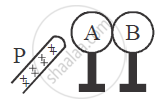
Consider the sacle of voltmeter shown in the diagram and answer the following questions :
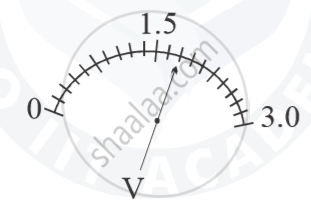
(a) What is the least count of the voltmeter?
(b) What is the reading shown by the voltmeter ?
(c) If the voltmeter is connected across a resistor of 20 `Omega` how much current is flowing through the resistor?
Fig. represents the circuit used for the verification of ohm's law. Label the different parts from A and F. State the function of each.
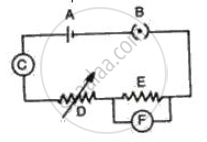
- Name and state the law which relates the potential difference and current in a conductor.
- What is the necessary condition for a conductor to obey the law named above in part (a) ?
The filament of a bulb takes a current 100 mA when potential difference across it is 0.2 V. When the potential difference across it becomes 1.0 V, the current becomes 400 mA. Calculate the resistance of filament in each case and account for the difference.
What is meant by the drift speed of free electrons?
State and define Ohm’s law.
Draw a neat diagram for the verification of Ohm’s law by voltmeter-ammeter method. By another diagram show the relation between p.d. and current.
Answer the following question.
Distinguish between Ohmic and non-ohmic substances; explain with the help of example.
State microscopic form of Ohm’s law.
An electronics hobbyist is building a radio which requires 150 Ω in her circuit, but she has only 220 Ω, 79 Ω, and 92 Ω resistors available. How can she connect the available resistors to get the desired value of resistance?
The slope of voltage (V) versus current (I) is called:
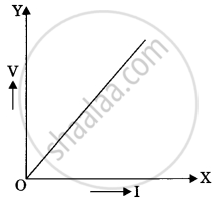
Assertion: The statement of Ohm’s law is K = IR.
Reason: V = IR is the equation which defines resistance.

Calculate the total resistance of the circuit and find the total current in the circuit.
A heater of 220 V heats a volume of water m 5 mint time. A heater of 110 V heat in ten second. The resistance of the conductor is
The heat produced by a 100 w heater in 2 minute is equal to
Two cells of same emf E but internal resistance r1 and r2 are connected in series to an external resistor R (Figure). What should be the value of R so that the potential difference across the terminals of the first cell becomes zero.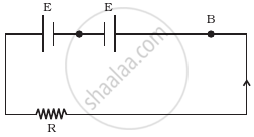
State Ohm's Law. Represent it mathematically.
What is the resistance of a conductor through which a current of 0.5 A flows when a potential difference of 2V is applied across its ends?
The resistance of a resistor is reduced to half of its initial value. If other parameters of the electrical circuit remain unaltered, the amount of heat produced in the resistor will become ______.
How is electric current related to the potential difference across the terminals of a conductor?
Draw a labelled circuit diagram to verify this relationship.
A current of 3.2 mA flows through a conductor. If charge on an electron is - 1.6 × 10-19 coulomb, find the number of electrons that will pass each second through the cross section of that conductor.
